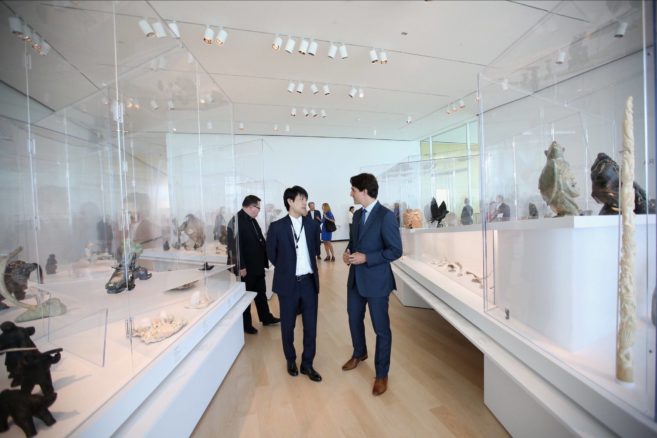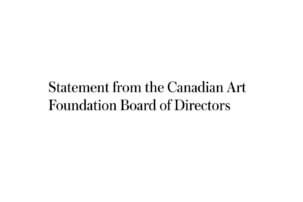“National Importance.”
It’s a phrase containing just two words.
But since a federal court ruling in June 2018, the presence of these two words in certain parts of the federal Cultural Property Export and Import Act have halted millions of dollars in artwork donations to museums and art galleries across Canada.
Yesterday, Budget 2019 offered a simple, if unexpected, solution to the impasse: a change to the act, and related taxation law, that means the “national importance” criteria no longer apply when it comes to obtaining specialized tax credits for artwork donations.
“Budget 2019 proposes to amend the Income Tax Act and the Cultural Property Export and Import Act to remove the requirement that property be of ‘national importance’ in order to qualify for the enhanced tax incentives for donations of cultural property,” says the budget document.
The new measure is considered effective as of Budget Day: March 19, 2019.
“Our reaction is a very positive one,” says Moira McCaffrey, executive director of the Canadian Art Museum Directors Organization (CAMDO-ODMAC). “The change is going to make possible, once again, significant donations of important cultural property to museums.”
McCaffrey and several CAMDO-ODMAC member museums are currently acting as intervenors in a federal court appeal to the June 2018 decision that made stricter interpretations of “national importance” a requirement in recent months.
“That [June 2018] decision greatly hindered donations,” McCaffrey explains. “I can tell you that quite a few museums across Canada have had to keep donation offers on hold, waiting to see how this situation would get resolved.”
The Canadian Museums Association also issued a statement, saying, “Hopefully, this plan will ensure that important cultural property remains here, for the benefit of all.”
More on Those Art-Law Budget Changes
While museums are welcoming this move in Budget 2019, some legal experts are watching to see what happens next—especially given that the June 2018 decision, which brought on the art-donations chill, is still under appeal.
“If the Federal Court of Appeal overturns the Federal Court’s original [June 2018] decision…. Then the changes proposed in the budget yesterday become almost moot,” says lawyer Alex Herman, a Canadian who works at the UK’s Institute of Art and Law in London.
Other legal observers say Budget 2019 brought in changes that should have been in Canada’s Cultural Property Export and Import Act from the very beginning of that legislation, in the 1970s.
“Good call by the feds,” says Toronto lawyer and art collector Aaron Milrad. He believes the original restrictions tying art-export criteria to art-donation tax-credit criteria produced too much interference with personal property and estate planning. “[Pierre] Trudeau said we don’t belong in the bedrooms of the nation,” Milrad says, “maybe we don’t belong in the living rooms of the nation, either.”
Yet Milrad, too, is uncertain what will happen to cultural property assessments that are currently in process.
“I don’t know how they are going to handle the set of donations currently in limbo,” Milrad says. “They’re like airplanes waiting to land.”
Moira McCaffrey, for her part, says the art museums that make up CAMDO-ODMAC will be waiting in coming weeks to see what new guidelines related to the Budget 2019 changes might be drawn up by the Cultural Property Export Review Board, or CPERB.
For decades, CPERB has been the body that makes determinations as to which artworks for museum donation are of sufficient “outstanding significance” and “national importance” to qualify for tax credits—what curators, appraisers and collectors like to call “OS/NI” criteria.
If Budget 2019 goes through—which is likely, given that Liberals still have a majority in Parliament, CPERB will, for the first time, be evaluating only the “OS”—“outstanding significance”—of potential artwork donations.
Budget 2019 Also Offers $16 Million More for Some Arts Festivals
Kate Cornell, co-chair of the Canadian Arts Coalition, says she was pleased to see a boost of $16 million to the Canadian Arts Presentation Fund in Budget 2019.
“It’s been a decade since this fund has had any investment,” says Cornell over the phone. “And the fund is incredibly oversubscribed,” so that $16 million is needed.
Cornell notes that the Canada Council for the Arts is working toward a doubling of its budget, and many more performance and dance works are now being created as a result. But without a similar growth of performance venues, there is a “bottleneck,” she says, between creation and presentation.
“This strategic investment in Canadian festivals and presenters is pivotal to ensure that diverse and innovative works created by Canadian artists can reach Canadian audiences,” Cornell also said in a release.
Cornell and her colleagues in the Canadian Arts Coalition had actually campaigned at Arts Day 2017 and Arts Day 2018 for the fund to be boosted by $30 million—and they got just above half of that in Budget 2019.
“We will continue to advocate for the importance of festivals and the arts in communities” moving forward, Cornell says. “It means more funding for existing festivals and select funding for a few new festivals.”
Yet it’s worth noting that visual arts festivals in particular might be challenged to meet the criteria of the newly boosted Canadian Arts Presentation Fund. That’s because the fund is only currently open to applications from festivals that extend, as the fund’s website puts it, “over a period of three days (minimum) to four weeks (generally).”
That requirement “excludes the ever-growing list of Nuit Blanche–style festivals,” says April Britski, executive director of CARFAC. “Most provinces have at least one of those now, and they are extremely popular and well-attended.”
Britski says she will be watching, though, to see if other Budget 2019 initiatives—like $24 million over two years to the Building Communities Through Arts and Heritage Program and the Celebration and Commemoration Program—might apply to visual arts or contemporary arts presenters as well.
A Generally Positive Approach to the Arts and Culture in the Budget
Britski also says she was pleased to see a generally positive approach to arts and culture in Budget 2019.
“Overall, I think the commitment to increased funding in the arts is very positive [and] I am encouraged to see the budget mention the fact that cultural industries make significant contributions to our economy.”
This is underlined in the first paragraph of the Budget 2019 under “Support for Diversity, Culture and the Arts”:
“Across the country, Canada’s artists and their supporters bring people together, to appreciate and celebrate the diversity and creativity that Canadians are known for the world over,” says the budget document. “Our cultural industries are also an important source of jobs—employing more than 650,000 Canadians—and are a key contributor to our economy, worth nearly $54 billion each year.”
Britski says this indicates the government is catching up to something CARFAC and other organizations have been saying for years.
“It’s finally getting through that the arts are not something just ‘nice to have,’” says Britski. “[The arts] are actually bringing money to communities, and the return on investment is high.”
Kate Cornell of the Canadian Arts Coalition says she was also encouraged to hear the arts make it into the budget speech by Finance Minister Bill Morneau—another overt form of acknowledgement of importance of the arts in Canada.
Cornell was also pleased, on a related note, to see $20 million over two years for the Canada Music Fund.
“To give more people here in Canada and around the world a chance to see, hear, and appreciate our talented and diverse artists, we’re making new investments that will help support our musicians, and bring festivals and performing arts series to more communities across the country,” Morneau said in the House of Commons yesterday.
Vanda Vitali, executive director of the Canadian Museums Association, also praised the budget overall, including its ongoing support for youth education and employment in museums and beyond.
“The Government of Canada is to be thanked for its foresight, financial support and recognition of the importance of museums and their essential role,” Vitali said in a release. “We look forward to continued federal support. The CMA and Canadian museums have been, and will continue to be, cultural leaders through our museum community across Canada.”
Much-Needed Funds for Gender Analysis in the Arts and More
Another smaller measure in the budget stood out to the Canadian Arts Coalition—and that is the commitment of $1 million allocated over two years for gender-based analysis and data in the arts and culture sector. This also applies to data collected by the Department of Canadian Heritage.
“When I was presenting to the Standing Committee on Canadian Heritage about gender parity last year, I told them the latest numbers I have in dance are from 2011,” says Kate Cornell of the Canadian Arts Coalition. She welcomes any effort to gather and disseminate more up-to-date data on gender and diversity in the arts.
Budget 2019 also says these monies will be used to “strengthen reporting requirements for…programs in order to better support gender equality and diversity in funding allocations.”
There is also more funding for Indigenous-language resourcing in Budget 2019—though some still have questions about how those monies will be distributed, and whether they are sufficient.
“There is…$333.7 million over the next five years earmarked for helping to revitalize Indigenous languages—a move that follows legislation introduced in February,” the CBC reports.
“For Indigenous languages, $333M spread over five years?” artist and activist Christi Belcourt tweeted after the budget release yesterday. “With over 60 languages, about 750 communities on and off reserve (total guess) minus admin at Heritage, we’ll be lucky if it supports one staff position each. How on earth do you revitalize a language with one person?”
Belcourt says she wasn’t sure how the funds would play out, but will be watching.
“I can’t stress enough how important it is that Indigenous languages are recognized as official languages in the upcoming Indigenous Languages Act,” Belcourt tweeted. “Because it triggers all of the funding to ENSURE the languages are supported properly.”

 Justin Trudeau met with musician Elton John and partner David Furnish in September 2018 to discuss the Elton John AIDS Foundation. Performing arts festivals and the Canada Music Fund are among those sectors finding a boost in Budget 2019. Photo: Facebook.
Justin Trudeau met with musician Elton John and partner David Furnish in September 2018 to discuss the Elton John AIDS Foundation. Performing arts festivals and the Canada Music Fund are among those sectors finding a boost in Budget 2019. Photo: Facebook.






